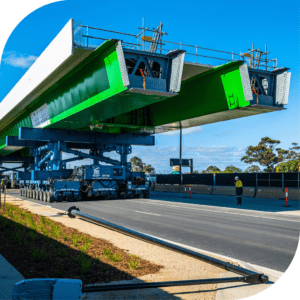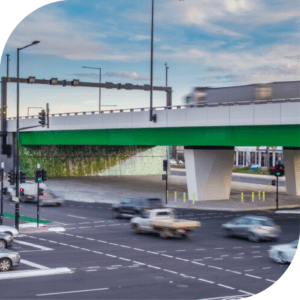Some jobs require tonnes of temporary steelwork just to construct, if you know what happens to it once the job is finished, then you may be interested in finding out what Bowhill are doing.
At the end of the main construction phase, have you ever thought, “what a waste, all that new temporary steel, it’s less than 6 months old and its being sent to the scrappy? We did, so now we’ve developed a process that helps our clients save money, time and importantly, helps our environment as well! Want to hear more about our solution that turns unwanted temp steel into your next project win?
 Many positives can be unlocked when reusing temporary project steel from job to job. The photos attached are from the R2P project in Adelaide and in this instance 2/3rds of the steel was reused with only 1/3rd of the entire support structure made from new steel. The new steel elements were necessary to ensure that the repurposed elements were suitable for the new application. From a budget standpoint, imagine the value that a repurposing solution could provide. I’m talking about using good steel that has already been built up. I have seen this reality many times, especially if your new requirement is similar to a project that’s been done previously. In this circumstance it’s likely that there’ll be some key elements that will shape the solution towards a very efficient outcome. Our environment is important to all of us, the emissions that are produced to make steel are significant, 1.85t of co2 in every tonne of new steel. It’s impressively lower at 400kg/t of co2 when producing new steel from fully recycled steel feed material but consider this, the production of emissions when using re-purposed steel is eliminated! The environmental benefits of using repurposed steel over recycling is good, but in comparison, repurposing is off the charts! If your company is chasing ambitious targets towards lower emissions, then this is a brilliant strategy to consider. Steel availability is not straightforward like it has been in the past, there is no doubting that steel is in high demand. Australian steel stock levels are lower and delivery times longer than they have possibly ever been. Designers are constantly having to tweak their design to accommodate available materials, which adds time, risk and cost.
Many positives can be unlocked when reusing temporary project steel from job to job. The photos attached are from the R2P project in Adelaide and in this instance 2/3rds of the steel was reused with only 1/3rd of the entire support structure made from new steel. The new steel elements were necessary to ensure that the repurposed elements were suitable for the new application. From a budget standpoint, imagine the value that a repurposing solution could provide. I’m talking about using good steel that has already been built up. I have seen this reality many times, especially if your new requirement is similar to a project that’s been done previously. In this circumstance it’s likely that there’ll be some key elements that will shape the solution towards a very efficient outcome. Our environment is important to all of us, the emissions that are produced to make steel are significant, 1.85t of co2 in every tonne of new steel. It’s impressively lower at 400kg/t of co2 when producing new steel from fully recycled steel feed material but consider this, the production of emissions when using re-purposed steel is eliminated! The environmental benefits of using repurposed steel over recycling is good, but in comparison, repurposing is off the charts! If your company is chasing ambitious targets towards lower emissions, then this is a brilliant strategy to consider. Steel availability is not straightforward like it has been in the past, there is no doubting that steel is in high demand. Australian steel stock levels are lower and delivery times longer than they have possibly ever been. Designers are constantly having to tweak their design to accommodate available materials, which adds time, risk and cost.
Choosing value-added steel elements that can be available through repurposing at the initial design phase is the best way to maximise the benefits. Then designing the scope with the intent of repurposing elements into the project makes good sense, it reduces material supply delays and drives down risk. We’ve seen many examples where the elements are already over-engineered for their new task. Because these elements are already value-added, the likelihood that they require reduced labour to complete the scope becomes a program and budget enhancement.
 There’s a short case study on our website demonstrating the savings that we were able to achieve by repurposing the steel, just on these two completed bridge assemblies there were several hundred thousand dollars of savings in comparison to what all new temporary steel would have cost our client. If there are SPMT movements for your upcoming project, the benefits of building the permanent assemblies at the SPMT’s starting point “at height” saves significant dollars as the specialised heavy lift/move contractors do not require additional jacking to installation height once they are positioned on the SPMTs.
There’s a short case study on our website demonstrating the savings that we were able to achieve by repurposing the steel, just on these two completed bridge assemblies there were several hundred thousand dollars of savings in comparison to what all new temporary steel would have cost our client. If there are SPMT movements for your upcoming project, the benefits of building the permanent assemblies at the SPMT’s starting point “at height” saves significant dollars as the specialised heavy lift/move contractors do not require additional jacking to installation height once they are positioned on the SPMTs.
Whilst temp steel is reused, it should always be done in a way that ensures that it is fit for purpose. Elements should be traced back to their mill certs and have the associated QA documentation to ensure it has the required structural integrity. Engineering analysis is still required with due consideration for the desired application. The design is most often the responsibility of the hirer, but we are able to provide shop drawings, and sometimes models, to assist in the FEA analysis or whatever process is required by your engineer.
If you find yourself in a situation where you have some budget challenges and you’re looking for a smart win to balance the ledger (without screwing the subbies), there are very few opportunities such as this that would be impactful enough to deliver meaningful results.
If you’d like to save money, reduce risk, program pressure, and co2 emissions as well as increase safety all in one smart move then the process of repurposing steel makes so much sense.
It is my belief that repurposing within the construction industry is a movement that will only grow, especially when the benefits of the process reach critical mass, there’ll be a point where if you don’t embrace it, you’ll run the risk of being left behind! We need more forward-thinking contractors that are willing to not just take up the benefits but also sell their useful temp steel at the end of the project so that it can be stored and used on future projects. We need to challenge the “send it to a scrappy” mentality where it consumes so much energy to meltdown and reform it into new steel.
With a perfect storm, there is so much to look forward to regarding this once in a generation infrastructure boom along with the growing public pressure to reduce emissions. It becomes a delicate juggling act where we must be environmentally prudent whilst at the same time find smarter ways to unlock savings.
Larger projects often require temporary steel to safely construct the structure. This temp steel is often scrapped at the completion of the process/project. Repurposing makes economic and environmental sense.
Repurposing is a growing trend that provides numerous benefits to the contractor and the environment.
Article by Jeremy Hawkes




